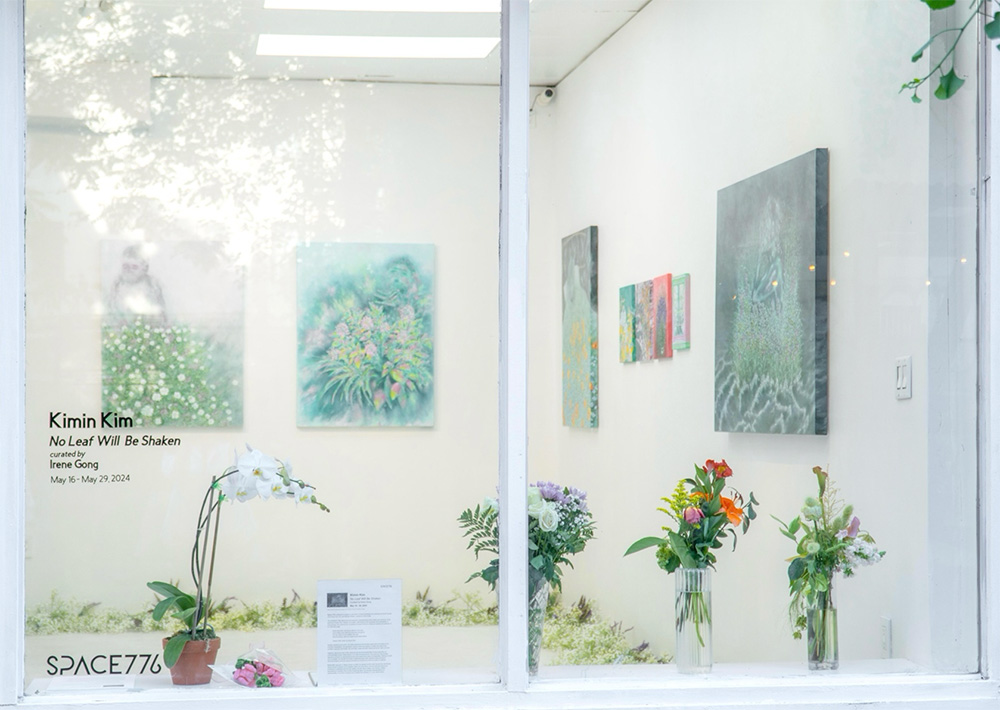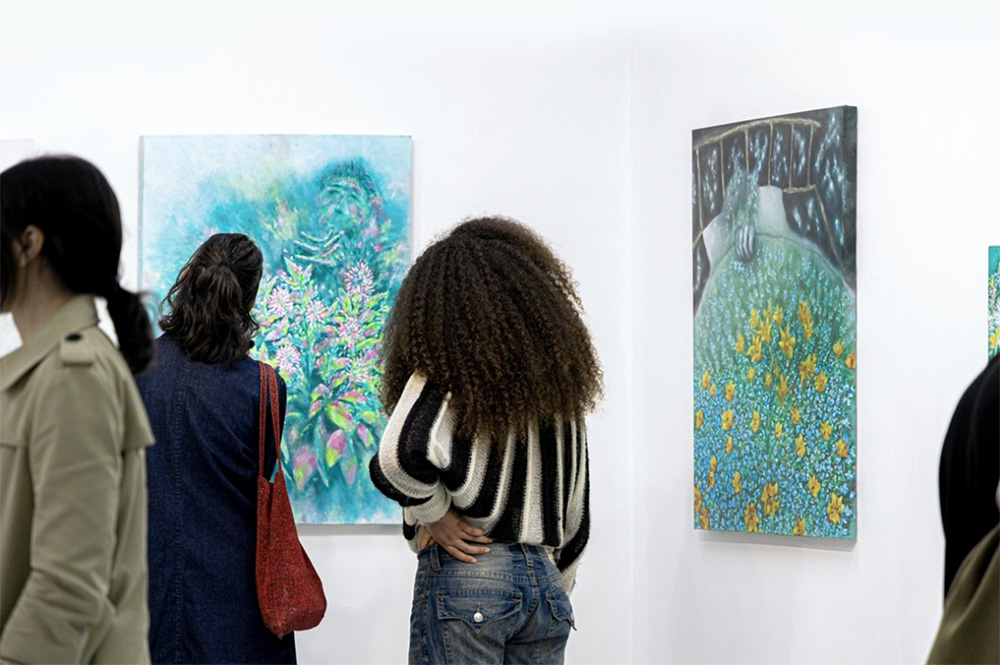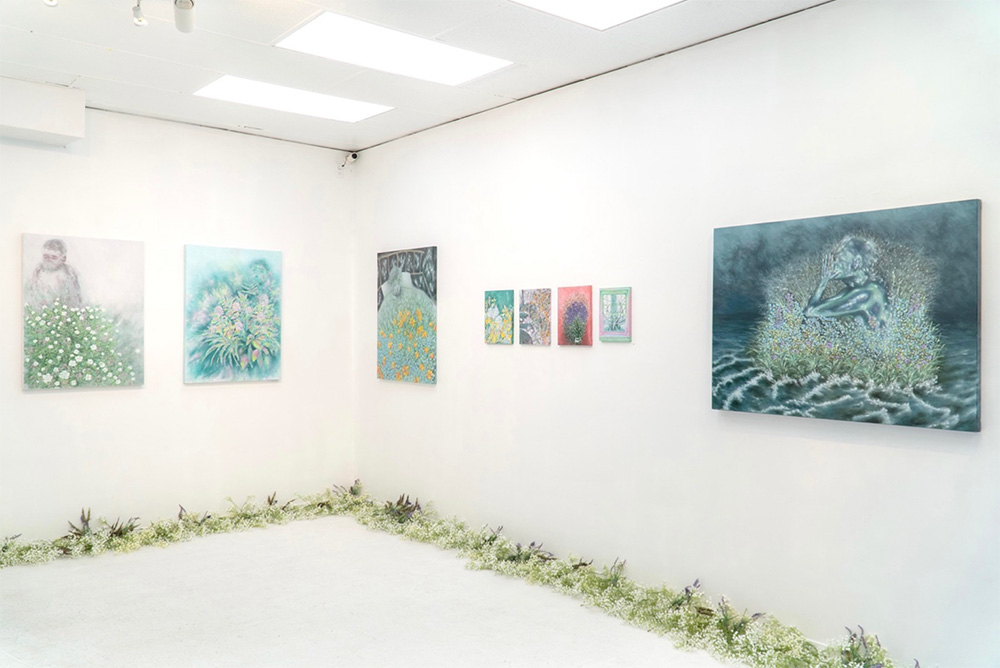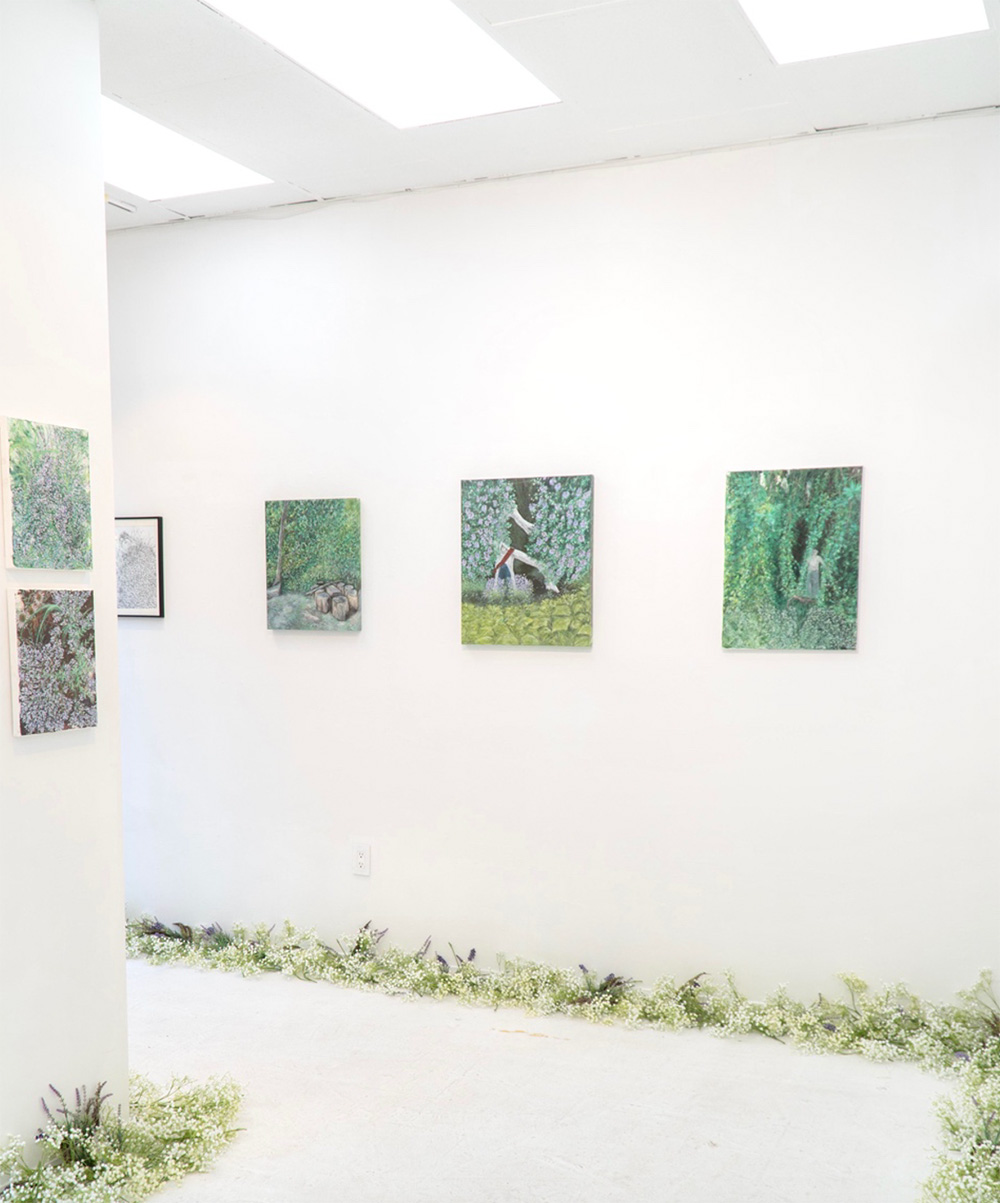The NY Art Life was fortunate enough to attend the solo exhibition, No Leaf Will be Shaken, curated by the talented Irene Gong at Space776 of Manhattan. From the moment we stepped into the gallery, we were transported into a world of captivating beauty and thought-provoking art. Each piece in the exhibit seamlessly blended tradition and modernity, creating a harmonious display that left us in awe. It was an immersive experience like no other, and we were thrilled to have the opportunity to explore the artist’s unique perspective.
Irene Gong’s curation was simply exceptional. How she curated the artworks in “No Leaf Will Be Shaken” showcased her deep understanding of the art scene and her ability to create a cohesive narrative within
the gallery space. The exhibition flowed effortlessly from one piece to another, allowing us to witness the evolution of tradition and modernity in Kimin Kim’s work. Gong’s attention to detail was evident in every aspect of the show, from the placement of each artwork to the lighting and ambiance of the space. She clearly had a clear vision and purpose behind her curation, and it truly enhanced our experience as viewers.
During our interview with Irene Gong, we delved deeper into her curatorial process and gained valuable insights into her ideas about curatorial work and the art scene in New York. Gong’s passion for art was palpable as she spoke about her desire to bring together different artistic styles and perspectives, creating a dialogue between tradition and modernity. She emphasized the importance of embracing diversity in art and allowing it to flourish in all its forms. Her dedication to showcasing artists who challenge traditional boundaries were evident in “No Leaf Will Be Shaken”, and it left a lasting impression on us.

Kiin Kim’s exhibition entitled “No Leaf Will Be Shaken” -Provided by Space776 Gallery
New York Art Life Magazine: I am surprised and fascinated by the visual harmony of this exhibition. What is the organizational and creative process that makes an exhibition successful? Or one that involves you emotionally, like this one I’m witnessing today.
Irene Gong: When organizing an exhibition, I focus on several key elements. I start by examining each artwork’s composition, technique, and aesthetic to grasp the artist’s style and vision. Next, I ensure the artworks are arranged to create a cohesive flow, balancing size, color, and subject matter for harmony within the space. The color palette is crucial as it influences the exhibition’s atmosphere and message, whether vibrant or subdued. I also prioritize a strong concept or theme to provide a meaningful context for the artworks. Lastly, I prefer solo exhibitions over group shows, as they offer a more immersive experience, allowing a deeper appreciation of one artist’s unique style and perspective.
New York Art Life Magazine: Why choose flowers and decorate the whole gallery? It is a fascinating glance, a display of elegance and harmony.
Irene Gong: Unlike traditional paintings, where flowers are merely depicted on canvas, Kimin’s work brings the flowers to life, making them an integral part of the painting itself. By adorning the gallery with real flowers and stems, we created an immersive experience for visitors, allowing them to feel as though they are stepping into Kimin’s vibrant and captivating world.
Incorporating flowers as the primary element in Kimin’s paintings adds a sense of vitality and beauty to his artwork. Decorating the gallery with these floral elements enhances the immersive nature of Kimin’s exhibition. Stepping into the gallery feels like entering a dreamlike garden, where visitors are surrounded by the very elements that inspired Kimin’s art. This unique approach allows viewers to connect with the artwork on a deeper level, as they physically experience the environment that influenced the creation of each painting.

Visitors during Kiin Kim’s exhibition – Provided by Space776 Gallery
New York Art Life Magazine: How do you choose the artist to present to the public?
Irene Gong: Choosing an artist is one of the most challenging aspects of our job. As someone who relies on visual experience, I need to see the works firsthand. Each choice involves navigating a dynamic and ever-changing landscape. While passion for art is crucial in guiding the decision-making process, it’s not enough on its own. A curator must also have a deep understanding of art history, movements, and styles. This expertise allows me to contextualize and present the artist’s work in a meaningful way.
I conduct extensive research on artists, artworks, and artistic movements, drawing information from books, articles, interviews, and archival materials. Critical thinking is essential; it involves analyzing and interpreting art to uncover deeper meanings beyond the surface. By engaging thoughtfully with the artwork, I aim to offer interpretations that enhance the viewer’s understanding and experience.
New York Art Life Magazine: Your passion for art is evident in your eyes when you talk about your work, and I noticed how much you care about every little detail in this exhibition.
Irene Gong: Attention to detail is a crucial skill for me. They must ensure accuracy in every aspect of their work, from researching information about the artist to organizing exhibitions or writing essays for catalogues. Attention to detail ensures that the artist’s work is presented in its truest form and that all accompanying information is correct and accurate. It also helps create a coherent narrative or theme within an exhibition, allowing viewers to understand better and appreciate the artist’s body of work.
New York Art Life Magazine: What is the philosophy behind an exhibition?
Irene Gong: An exhibition is not just about showcasing artwork; it is a platform for artists to express their creativity and for curators to craft a meaningful narrative. The philosophy behind an exhibition is to engage the viewer, tell a story, and guide them on a journey through the artist’s work. While the artist aims to create art that resonates with the audience, my role is to present and immerse the viewer in the genesis of the paintings. This approach can be likened to storytelling, where each artwork carries its own narrative and meaning that the artist wishes to convey. The exhibition space, whether a gallery or a museum, is crucial in bringing this philosophy to life. It is not merely about hanging pictures on the wall but about creating an environment that enhances the viewer’s experience and fosters a deeper connection with the artwork. In this regard, a gallery aligns closely with the concept of a museum, as both aim to engage and educate the viewer through thoughtfully curated exhibitions.

Details of the floral arrangement of the exhibition – Provided by Space776 Gallery
New York Art Life Magazine: Irene, you are a rising curator here in New York, and the public recognizes you for your extraordinary creativity in curation. What is the common thread of all the exhibitions you have created?
Irene Gong: What guides me in presenting exhibitions is warmth. I believe that creating a welcoming atmosphere is crucial for ensuring that visitors feel comfortable and engaged. It’s like being embraced in a warm hug, where individuals do not feel lost or alone. Warmth has the power to captivate and connect people, making them feel familiar and at ease. In contrast, boredom is cold and isolating. By infusing warmth into my exhibitions, I strive to create an environment where art can be fully appreciated and enjoyed by everyone.
New York Art Life Magazine: How did you decide to become a curator?
Irene Gong: Becoming a curator was not something I had planned, but the timing turned out to be perfect. During the pandemic, I returned to Korea and unexpectedly had the opportunity to learn painting with the renowned Korean contemporary artist Sara Lee at an artist residency an hour away from Seoul. While there, I began to learn how to paint and decided to hold my solo exhibition titled “Nature & Tradition”. It was a pivotal moment for me, as I learned to paint and created my works in silence at the studio, visiting the residency once a week.
Since returning from New York, I had been searching for my identity and interests. I held my first exhibition at a gallery in the heart of Bukchon Hanok Village, known for its rich Korean culture and traditional architecture. The space was ideal for an exhibition, especially following my solo show. The success of this exhibition boosted my confidence and deepened my interest in contemporary art and curatorial studies.
Before returning to New York to study at the prestigious Sotheby’s Institute of Art, I participated in a group exhibition with two other students from my painting class at Lydia Gallery in Seoul, marking the end of that chapter. I then continued my studies and began my pursuit of working in the art industry and exhibition curation in New York.
New York Art Life Magazine: This story is interesting and impressive—a great start to a novel set here in New York. What area of study have you found most engaging?
Irene Gong: I am currently studying contemporary art, which involves extensive research and analysis, exhibition reviews, and curatorial assignments, along with learning critical theories and criticism in the art world. While I am drawn to immersive art installations and experiences, I especially appreciate participatory art because it requires active involvement to complete the artwork. In participatory art, the audience does not simply view the finished work as a third party but collaborates with the artist to complete the piece. Additionally, I have discovered that I enjoy working with and talking to artists, drawing inspiration from their imaginations and unique perspectives. This interaction is one of the beauties of art—it serves as a shared yet intricate visual language that resonates across generations.

Details of the floral arrangement of the exhibition – Provided by Space776 Gallery
New York Art Life Magazine: How wonderful!!! With **three decades** of immersion in the art and events realm, I’ve witnessed the ever-evolving landscape of creative expression and curation. It’s with this wealth of experience that I can confidently assert: *many curators would resonate deeply with your vision of art*. This alignment isn’t merely a coincidence; it’s a testament to the shared passion and discerning eye that develops over years of engaging with diverse artistic forms. Throughout my journey, I’ve observed how curators, despite their individual approaches, often converge on certain fundamental principles that define compelling art. This collective wisdom, honed through countless exhibitions and events, speaks to the universal truths that great art embodies. Whether it’s the power to provoke thought, evoke emotion, or challenge perceptions, your vision likely taps into these core elements that seasoned curators recognize and champion. I’m thrilled to hear about your thoughtful approach as a curator who is willing to work closely with artists. What is your next step in the art world?
Irene Gong: I would love to exhibit more Korean artists working around the globe in New York, particularly focusing on solo or debut exhibitions. I solidified this goal after curating my own show in Seoul and presenting Kimin’s works as his debut solo exhibition in New York. The city boasts a rich history and vibrant culture in contemporary art, and I would be honored to collaborate closely with artists to develop curatorial themes that best represent their practices and make a lasting impression.
Max Anthony Sciarra stands as a testament to the vibrant intersection of journalism and art in New York City. This multifaceted individual has carved a unique niche for himself as a respected journalist, and insightful writer. Sciarra’s journey in the world of art and culture isn’t confined to the bustling streets of New York; his experiences in the romantic city of Paris and the fashion capital of Milan have added rich layers to his perspective. With an unwavering passion for art, Sciarra has collaborated extensively with numerous galleries and artistic events, bridging the gap between creators and audiences. His crowning achievement, the founding of New York Art Life Magazine, serves as a beacon for art enthusiasts, illuminating the city’s extraordinary artistic landscape. Through this platform, Sciarra continues to champion the diverse and dynamic art scene that makes New York a global cultural hub, ensuring that both emerging talents and established artists receive the recognition they deserve.





